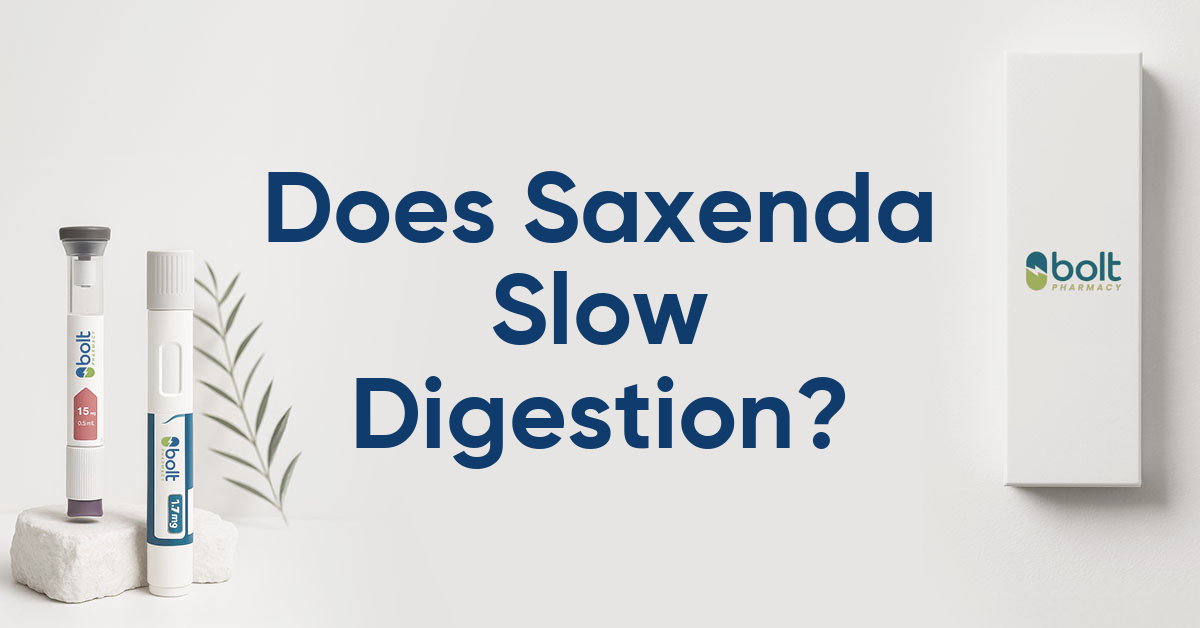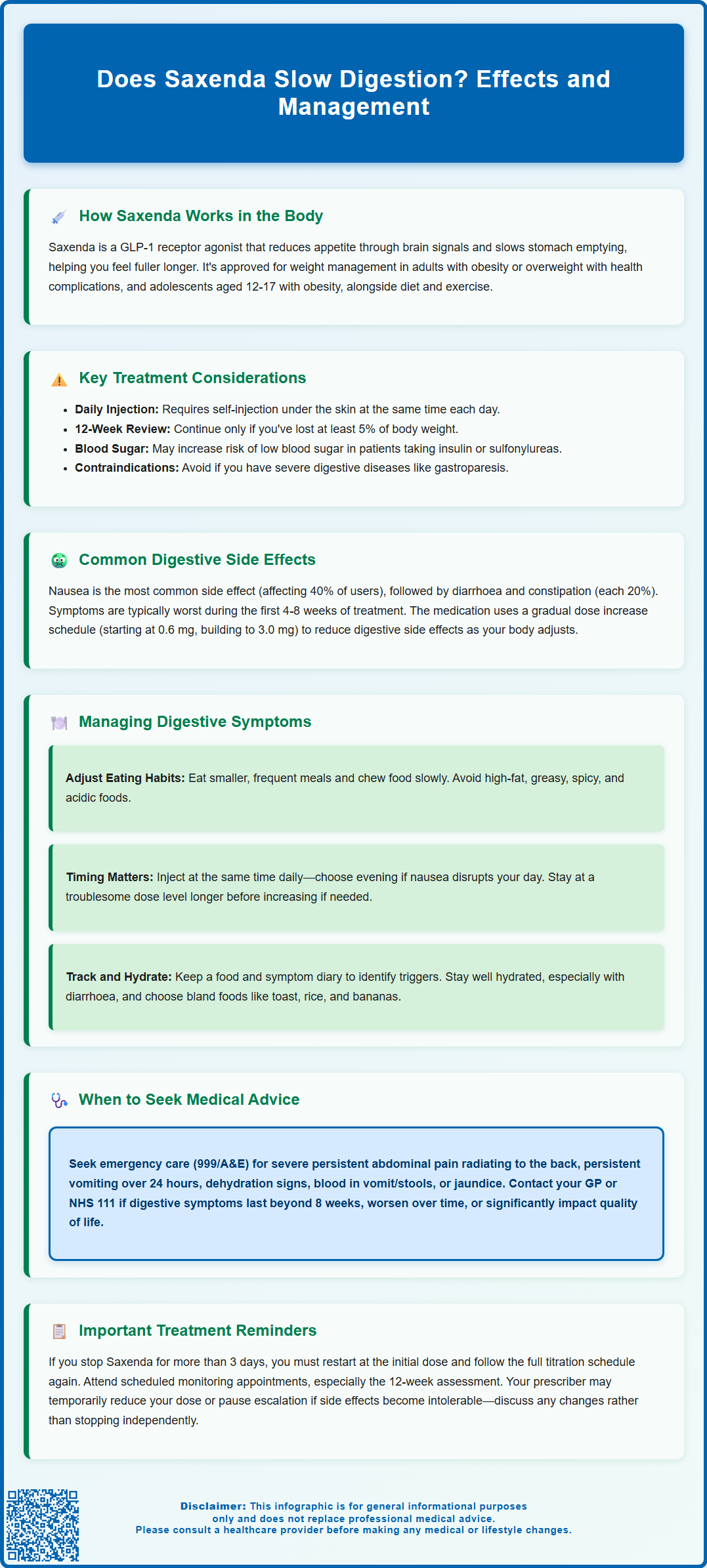Wegovy®
A weekly GLP-1 treatment proven to reduce hunger and support meaningful, long-term fat loss.
- ~16.9% average body weight loss
- Boosts metabolic & cardiovascular health
- Proven, long-established safety profile
- Weekly injection, easy to use

Does Saxenda slow digestion? Yes, Saxenda (liraglutide 3.0 mg) does slow gastric emptying, which is the rate at which food moves from the stomach into the small intestine. This glucagon-like peptide-1 (GLP-1) receptor agonist is licensed in the UK for weight management in adults with obesity or overweight with weight-related comorbidities. By delaying gastric emptying, particularly during early treatment, Saxenda helps you feel fuller for longer after eating, contributing to reduced calorie intake. This pharmacological effect commonly manifests as gastrointestinal side effects, which typically improve as your body adjusts to the medication.
Summary: Saxenda slows gastric emptying, delaying the movement of food from the stomach into the small intestine, which contributes to prolonged fullness and reduced calorie intake.
Saxenda (liraglutide 3.0 mg) is a glucagon-like peptide-1 (GLP-1) receptor agonist licensed in the UK for weight management in adults with obesity or overweight with weight-related comorbidities, and in adolescents aged 12 to <18 years with obesity. The medication mimics the action of naturally occurring GLP-1, a hormone released by the intestine in response to food intake.
The primary mechanism through which Saxenda aids weight loss involves central effects on appetite and satiety regulation via the hypothalamus in the brain, reducing hunger signals and increasing feelings of fullness. Additionally, Saxenda slows gastric emptying (the rate at which food moves from the stomach into the small intestine), particularly during early treatment. This contributes to feeling fuller for longer after eating, reducing overall calorie intake. This delayed gastric emptying is a pharmacological effect that commonly manifests as gastrointestinal side effects.
Saxenda also influences blood glucose regulation by stimulating insulin secretion in a glucose-dependent manner and suppressing inappropriate glucagon release. This means insulin is released only when blood glucose levels are elevated, though patients taking insulin or sulfonylureas may have an increased risk of hypoglycaemia. The medication is administered once daily via subcutaneous injection, typically in the abdomen, thigh, or upper arm.
The MHRA-approved indication for Saxenda requires its use alongside a reduced-calorie diet and increased physical activity. NICE Technology Appraisal (TA664) recommends liraglutide within specialist weight management services for adults meeting specific criteria. Treatment should be reviewed after 12 weeks at the maintenance dose of 3.0 mg and continued only if at least 5% weight loss has been achieved. Saxenda is not recommended for people with severe gastrointestinal disease (such as gastroparesis) and patients should maintain adequate hydration to reduce the risk of dehydration and kidney problems.

Gastrointestinal side effects are the most commonly reported adverse reactions with Saxenda, affecting a significant proportion of users, particularly during the initial weeks of treatment. These effects relate to the medication's actions on the digestive system, including slowed gastric emptying and altered gut motility.
The most frequent digestive symptoms include:
Nausea – reported by approximately 40% of patients in clinical trials, typically most pronounced during dose escalation
Diarrhoea – affecting around 20% of users, which may alternate with constipation
Constipation – occurring in approximately 20% of patients due to slowed intestinal transit
Vomiting – experienced by roughly 16% of users, often associated with eating too quickly or consuming large portions
Dyspepsia (indigestion) – including feelings of fullness, bloating, and upper abdominal discomfort
Abdominal pain or discomfort – ranging from mild cramping to more persistent discomfort
These symptoms are generally most pronounced during the first 4–8 weeks of treatment and often improve as the body adjusts to the medication. The graduated dose titration schedule (starting at 0.6 mg daily and increasing weekly to the maintenance dose of 3.0 mg) is specifically designed to minimise gastrointestinal intolerance.
In clinical trials, gastrointestinal adverse effects were the most common reason for treatment discontinuation, with approximately 9% of patients stopping Saxenda due to these symptoms. However, the majority of users experience mild to moderate symptoms that resolve with continued use.
More serious digestive risks include pancreatitis and gallbladder problems (including gallstones and inflammation), with the latter associated with both GLP-1 medications and rapid weight loss itself. Severe or persistent vomiting or diarrhoea can lead to dehydration and potential kidney problems. Severe or persistent gastrointestinal symptoms warrant medical review, as they may indicate the need for dose adjustment or alternative management strategies. Suspected adverse reactions can be reported via the MHRA Yellow Card scheme.
Practical dietary and lifestyle modifications can significantly reduce digestive discomfort while taking Saxenda, allowing you to continue treatment and achieve your weight management goals.
Dietary strategies to minimise symptoms:
Eat smaller, more frequent meals rather than three large meals daily – this works with Saxenda's effect on gastric emptying rather than against it
Chew food thoroughly and eat slowly to aid digestion and prevent overwhelming your slowed digestive system
Avoid high-fat, greasy, or fried foods which take longer to digest and may exacerbate nausea and bloating
Limit spicy, acidic, or heavily seasoned foods during the initial adjustment period
Stay well hydrated by drinking water throughout the day, particularly if experiencing diarrhoea
Reduce carbonated beverages which can increase bloating and abdominal discomfort
Consider bland, easily digestible foods such as toast, rice, bananas, and lean proteins when nausea is problematic
Timing and administration considerations:
Administer your Saxenda injection at a consistent time each day. Some patients find that injecting in the evening helps them sleep through any nausea, while others prefer morning administration – find what works best for you. If gastrointestinal symptoms are troublesome at a particular dose level, discuss with your prescriber whether staying at that dose for an additional week before increasing might be appropriate. If symptoms are severe, your prescriber may recommend temporarily reducing to the last tolerated dose.
If you interrupt treatment for more than 3 days, you'll need to restart with the initial dose and follow the titration schedule again, as per the product guidance.
Additional management approaches include keeping a food and symptom diary to identify specific triggers, ensuring adequate fibre intake to manage constipation (though introduce gradually), and considering ginger tea for nausea (discuss any supplements with your pharmacist or GP first). Over-the-counter medications such as antacids may provide relief for dyspepsia, but always consult your pharmacist or GP before adding new medications. Regular physical activity, even gentle walking, can help maintain healthy digestive function and reduce bloating.
While mild to moderate digestive symptoms are expected with Saxenda, certain warning signs require prompt medical attention. Understanding when to contact your healthcare provider ensures your safety and appropriate management of potential complications.
Seek urgent medical advice (call 999 or go to A&E) if you experience:
Severe, persistent abdominal pain, particularly if located in the upper abdomen and radiating to the back – this may indicate pancreatitis, a rare but serious adverse effect
Persistent vomiting preventing you from keeping down fluids or medications for more than 24 hours, risking dehydration
Signs of dehydration including dark urine, dizziness, reduced urination, or extreme thirst
Blood in vomit or stools, or black, tarry stools suggesting gastrointestinal bleeding
Severe diarrhoea lasting more than 48 hours or accompanied by fever
Symptoms of gallbladder disease such as intense right upper abdominal pain, yellowing of skin or eyes (jaundice), or pale stools
Contact your prescriber, use NHS 111, or see your GP promptly if:
Gastrointestinal symptoms persist beyond 8 weeks without improvement
Symptoms significantly worsen rather than improve over time
You're unable to tolerate the dose escalation schedule
Digestive issues are substantially affecting your quality of life or nutritional intake
You develop new or unexplained symptoms
You're experiencing unexpectedly rapid or symptomatic weight loss
Treatment monitoring is an important part of Saxenda therapy. Your specialist weight management service will arrange reviews according to local protocols, with a key assessment after 12 weeks at the 3.0 mg dose to determine whether treatment should continue (typically requiring at least 5% weight loss from baseline, per NICE TA664). These appointments provide opportunities to discuss digestive symptoms and adjust your treatment plan.
Your prescriber may recommend temporarily reducing the dose, pausing escalation, or considering alternative weight management strategies if side effects are intolerable. Always discuss any changes to your Saxenda treatment with your healthcare provider rather than stopping on your own, and remember that if treatment is interrupted for more than 3 days, you'll need to restart with the titration schedule.
Digestive side effects such as nausea, diarrhoea, and constipation are generally most pronounced during the first 4–8 weeks of treatment and often improve as your body adjusts to the medication. The graduated dose titration schedule is specifically designed to minimise gastrointestinal intolerance.
Dietary modifications such as eating smaller, more frequent meals, avoiding high-fat foods, and staying well hydrated can significantly reduce nausea. Always consult your pharmacist or GP before taking over-the-counter medications or supplements alongside Saxenda.
Seek urgent medical attention for severe persistent abdominal pain (especially radiating to the back), persistent vomiting preventing fluid intake, signs of dehydration, blood in vomit or stools, or symptoms of gallbladder disease. Contact your GP if symptoms persist beyond 8 weeks or significantly affect your quality of life.
The health-related content published on this site is based on credible scientific sources and is periodically reviewed to ensure accuracy and relevance. Although we aim to reflect the most current medical knowledge, the material is meant for general education and awareness only.
The information on this site is not a substitute for professional medical advice. For any health concerns, please speak with a qualified medical professional. By using this information, you acknowledge responsibility for any decisions made and understand we are not liable for any consequences that may result.
Lorem ipsum dolor sit amet, consectetur adipiscing elit, sed do eiusmod tempor incididunt ut labore et dolore magna aliqua. Ut enim ad minim veniam, quis nostrud exercitation ullamco laboris nisi ut aliquip ex ea commodo consequat. Duis aute irure dolor in reprehenderit in voluptate velit esse cillum dolore eu fugiat nulla pariatur.
Block quote
Ordered list
Unordered list
Bold text
Emphasis
Superscript
Subscript